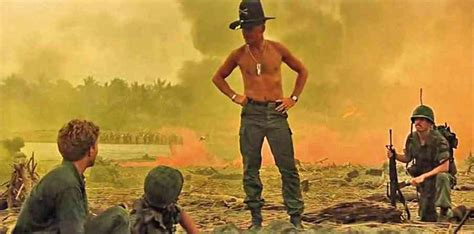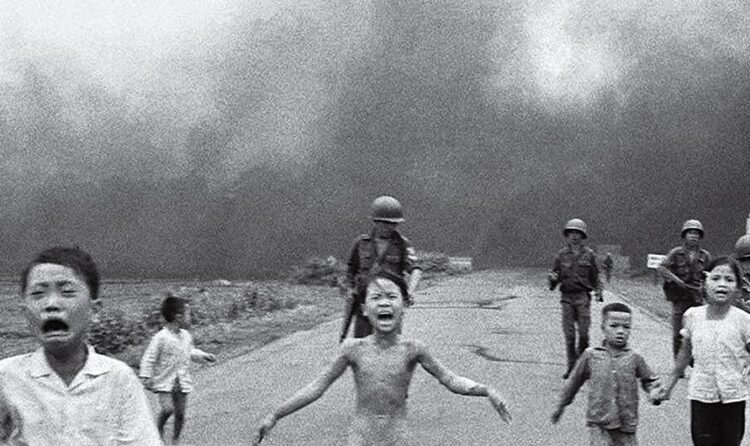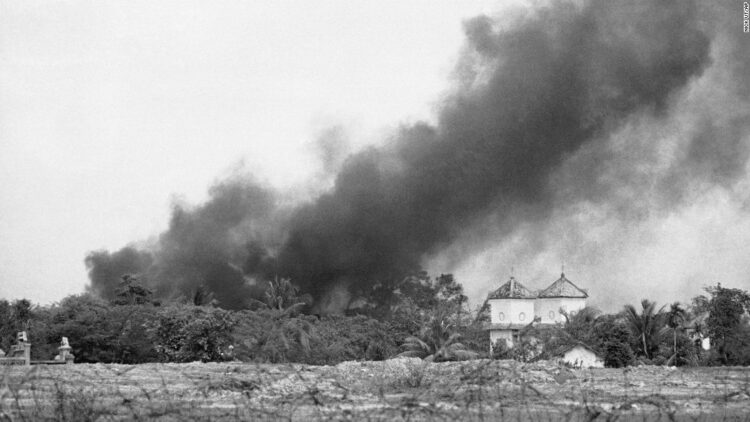My father told me that he once raced the family car, with my siblings and me to the beach at Vung Tau while the American military laid down some napalm near the highway. He was trying to get us there before the road was closed, for our local day-cation. Anyone who saw the movie Apocalypse Now recalls the movie lines that actor Robert Duvall delivers excellently as the character Lieutenant Colonel Kilgore.
I love the smell of napalm in the morning. You know, one time we had a hill bombed for 12 hours. When it was all over, I walked up. We didn’t find one of ’em, not one stinkin’ dink body. The smell, you know that gasoline smell, the whole hill. Smelled like victory.
We also see its use as told in the movie We Were Soldiers, starring actor Mel Gibson. It wasn’t all fun and games in Vietnam. The Vietnam War yielded numerous unforgettable images of explosions and their aftermath, yet none is as enduring and iconic as the one captured by Associated Press photographer Nick Ut, featuring Phan Thi Kim Phuc. Kim Phuc was just 9 years old when she and a fellow villager fell victim to an accidental napalm strike by a South Vietnamese plane. In the famous photograph posted below, Kim Phuc is seen alongside a group of terrified children, desperately running away from their village. She is naked, her cries of agony piercing the air as napalm burns her body.
Upon realizing the extent of her injuries, Nick Ut rushed Kim Phuc to a hospital. Miraculously, she survived but not without enduring extensive third-degree burns and undergoing 17 surgeries. In her late teens and early twenties, the Vietnamese government exploited Kim Phuc as a propaganda tool, compelling her to speak to foreign reporters. Eventually, she and her husband escaped to Canada, where she now resides in a suburb of Toronto. Despite continuing to grapple with the pain from her injuries, she courageously shares her experiences and speaks publicly about the horrors of napalm. Additionally, Kim Phuc serves as a U.N. Goodwill Ambassador. The photograph taken by Nick Ut, along with images of burning monks, stands as one of the most widely recognized and impactful visuals from the Vietnam War. Thankfully she recovered and as proven to be a resilient woman. In 1982 she found a New Testament in a library that led her to become a Christian, and got asylum in Canada after a sanctioned trip to Cuba from Vietnam.
The utilization of fire as a weapon dates back to ancient times. Greek fire, often referred to as “sticky fire,” is believed to have been formulated with a petroleum base. The advent of napalm can be traced back to World War II, when Allied forces began employing jellied gasoline mixtures.
In 1939, the Soviet Union pioneered the use of aluminum salts of organic acids, known as Ionov’s salt, to create incendiary viscous mixtures, which gained significant favor within the Red Army. These early incendiary devices relied on latex, but a shortage of natural rubber arose due to the Japanese army’s capture of rubber plantations in Malaya, Indonesia, Vietnam, and Thailand.
This scarcity of natural rubber prompted American companies such as DuPont and Standard Oil of New Jersey, along with researchers at Harvard University, to embark on the development of synthetic alternatives for various applications, including vehicle tires, tank tracks, gaskets, hoses, medical supplies, and rainwear. In 1942, a team of chemists, led by Louis Fieser at Harvard University, successfully created synthetic napalm. Initially, the production of napalm was entrusted to Nuodex Products, and by mid-April 1942, they had produced a brown, dry powder that lacked stickiness on its own but became an extremely adhesive and flammable substance when mixed with gasoline. One of Fieser’s colleagues suggested incorporating phosphorus into the mixture, enhancing its ability to penetrate deep into musculature and continue burning for an extended duration.
During the Vietnam War, napalm emerged as an integral component of US military operations, as American forces increasingly harnessed its capabilities for both tactical and psychological purposes. Napalm is a combustible concoction composed of a thickening agent and a volatile petrochemical. The name itself is a fusion of two key components found in the original thickening and gelling agents: coprecipitated aluminum salts of naphthenic acid and palmitic acid. In 1942, a team under the leadership of chemist Louis Fieser secretly developed napalm for the US Chemical Warfare Service within Harvard University’s clandestine laboratory.
Initially, the primary interest in napalm revolved around its potential as an incendiary weapon for use in firebombing campaigns during World War II. Its unique ability to be projected as a cohesive stream over a significant distance, rather than dispersing like a typical gasoline fireball, led to its widespread adoption, particularly in infantry flamethrowers.
Napalm burns at temperatures ranging from 800 to 1,200 °C. It possesses a longer burning duration than gasoline, has superior dispersal properties, and adheres effectively to its targets. These characteristics have made it both highly efficient and the subject of controversy. Napalm has seen extensive deployment from both aerial and ground platforms. One of its largest-scale uses was through airdropped bombs during the incendiary attacks on Japanese cities in 1945 during World War II. It also played a role in close air support operations during the First Indochina War, the Algerian War, the Korean War, and the Vietnam War.
Napalm has greatly enhanced the capabilities of flamethrowers, including those mounted on tanks, ships, and infantry units, since World War II. This versatile weapon was employed extensively in urban combat scenarios by both the Axis and the Allies during World War II.
*The views and opinions expressed on this website are solely those of the original authors and contributors. These views and opinions do not necessarily represent those of Spotter Up Magazine, the administrative staff, and/or any/all contributors to this site.
SOURCE
https://en.wikipedia.org/wiki/Phan_Thi_Kim_Phuc
https://science.howstuffworks.com/napalm.htm
https://groovyhistory.com/i-love-the-smell-of-napalm-in-the-morning-apocalypse-now



